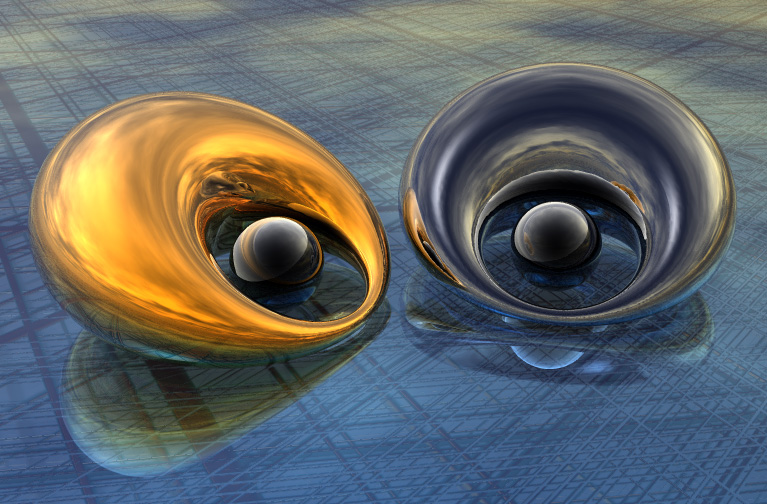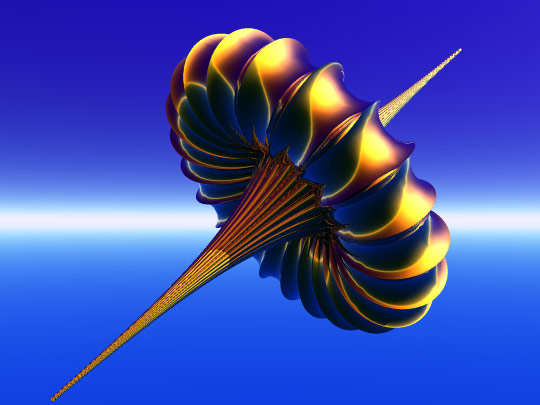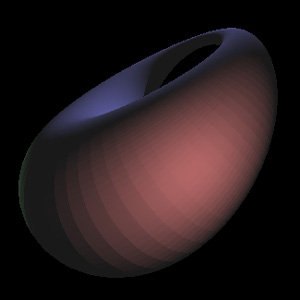Surf format, save-as from 3D-XplorMathWritten by Paul BourkeDecember 2004 Format specification assistance from Richard Palais and testing by Luc Benard.
The surf format is an export format from the 3D-XplorMath software. The format is ascii printable characters so it can be opened and inspected in any text editor. All surfaces are parametric of 2 variables, called (u,v), a grid.
procedure SaveSurfaceToDisk;
var
i,j,k:longint;
begin
writeln(MyTextFile, 'SurfaceDataFile');
writeln(MyTextFile, 3); //file version
writeln(MyTextFile, uResolution);
writeln(MyTextFile, vResolution);
writeln(MyTextFile, NumberOfTiles);
writeln(MyTextFile, ViewPoint.x);
writeln(MyTextFile, ViewPoint.y);
writeln(MyTextFile, ViewPoint.z);
writeln(MyTextFile, ViewDirection.x);
writeln(MyTextFile, ViewDirection.y);
writeln(MyTextFile, ViewDirection.z);
writeln(MyTextFile, ImagePlaneCenter.x);
writeln(MyTextFile, ImagePlaneCenter.y);
writeln(MyTextFile, ImagePlaneCenter.z);
writeln(MyTextFile, ImagePlaneXDirection.x);
writeln(MyTextFile, ImagePlaneXDirection.y);
writeln(MyTextFile, ImagePlaneXDirection.z);
writeln(MyTextFile, ImagePlaneYDirection.x);
writeln(MyTextFile, ImagePlaneYDirection.y);
writeln(MyTextFile, ImagePlaneYDirection.z);
writeln(MyTextFile, FocalLength);
writeln(MyTextFile, Graphic_Scale);
writeln(MyTextFile, EyeSeparation);
writeln(MyTextFile, ClipDistance);
for i := 1 to uResolution do
begin
for j := 1 to vResolution do
begin
writeln(MyTextFile, MySurface^^[i,j].x);
writeln(MyTextFile, MySurface^^[i,j].y);
writeln(MyTextFile, MySurface^^[i,j].z);
end;
end;
if NumberOfTiles > 1 then
for i := 1 to 4 do
for j := 1 to 3 do
for k := 1 to NumberOfTiles do
writeln(MyTextFile, TMatrix[i,j,k]);
for k := 1 to NumberOfTiles do
writeln(MyTextFile, NormalCorrectors[k]);
end;
Sample surf file: cyclide.surf.gz
surfconvDownload Mac OS-X version: surfconv.zip. This has been removed since obj format export has now been added to 3D-XplorMath.surfconv is a Unix style application that reads a surf files as exported by 3D-XplorMath and writes to standard out either a PovRay or Wavefront OBJ representation. This utility was written to enable the surfaces supported by 3D-XplorMath to be imported into other rendering/modelling packages. Usage: surfconv [options] surfname Options -pov povray file (default) -obj wavefront object file -geom GEOM ouput format -smooth estimate normals at each vertex Example: surfconv -smooth -pov mysurf.surf The PovRay and Wavefront OBJ formats both support vertex and index face primitives, this is standard for OBJ files and supported in PovRay with the recently introduced mesh2{} primitive [See PovRay documentation for details]. The surf format does not include colour information so colour is not available in the output file. For PovRay the surface is assigned a texture called "surf_texture" which can be declared by the user. The surf format does not store vertex normals however these can be optionally estimated by the converter. Both the PovRay and Wavefront OBJ formats and corresponding rendering engines can use these to give a better rendering result.
The Wavefront OBJ includes texture coordinates in (u,v), the converter assigns linear texture coordinates from 0 to 1 in both dimensions. For a tiled model each tile will have independent texture coordinates.  Reimann minimal surface constructed from 4 tiles. Rendering courtesy of Luc Benard. No attempt has been made to transfer the camera specifications to the output files. While this is possible for the PovRay, it isn't for OBJ files and the purpose of this utility to transfer the geometry for editing within modelling/rendering/animation packages. The normals at each vertex are estimated by considering the normals of the grid cells the vertex shares. The contribution of a cell is proportional to the area of the cell. Examples courtesy of Luc Benard



|

